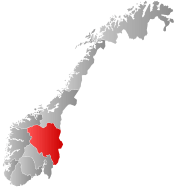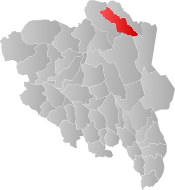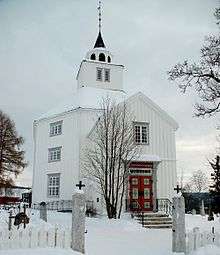Tolga, Norway
Tolga is a municipality in Innlandet county, Norway. It is part of the traditional region of Østerdalen. The administrative centre of the municipality is the village of Tolga. The municipality is bordered in the east by the municipality of Tynset, in the south by Rendalen, and in the east by Engerdal and Os, all in Hedmark county.
Tolga kommune | |
|---|---|
 | |
 Coat of arms  Innlandet within Norway | |
 Tolga within Innlandet | |
| Coordinates: 62°24′5″N 11°1′20″E | |
| Country | Norway |
| County | Innlandet |
| District | Østerdalen |
| Administrative centre | Tolga |
| Government | |
| • Mayor (2011) | Ragnhild Aashaug (Sp) |
| Area | |
| • Total | 1,123 km2 (434 sq mi) |
| • Land | 1,098 km2 (424 sq mi) |
| Area rank | 91 in Norway |
| Population (2018) | |
| • Total | 1,553 |
| • Density | 1.4/km2 (4/sq mi) |
| • Change (10 years) | |
| Demonym(s) | Tolging[1] |
| Time zone | UTC+01:00 (CET) |
| • Summer (DST) | UTC+02:00 (CEST) |
| ISO 3166 code | NO-3426 |
| Official language form | Neutral[2] |
| Website | www |
General information
Name
The municipality (originally the parish) is named after the old Tolga farm because the first church in the parish was built here (in 1688). The farm is named after the small Tolga River, and the river name is probably derived from the word toll, which means '(young) pine (tree)'. Prior to 1918, the name was spelled Tolgen.[3]

Coat-of-arms
The coat-of-arms is from modern times. They were granted on 14 July 1989. The arms show a gold bell on a red background. Tolga was home to the smeltehytte from 1666 to 1871, and the bell represents the old bell in the town square at the center of Tolga. The smeltery was important because of the prevalence of mining in the area.[4]
History
The parish of Tolgen was established as a municipality on 1 January 1838 (see formannskapsdistrikt). Some parts of Tolga were transferred to the neighboring municipality of Engerdal on 1 January 1911. The new municipality of Os was separated from Tolga on 1 July 1926. (Tolga and Os were briefly merged from 1966 to 1976. See Tolga-Os.)
Tolga Church (Tolga Kirke) is an octagonal church built in 1840. The edifice is of timber and it has 400 seats. The previous church on the site was built in 1688.
References
- "Navn på steder og personer: Innbyggjarnamn" (in Norwegian). Språkrådet.
- "Forskrift om målvedtak i kommunar og fylkeskommunar" (in Norwegian). Lovdata.no.
- Rygh, Oluf (1900). Norske gaardnavne: Hedmarkens amt (in Norwegian) (3 ed.). Kristiania, Norge: W. C. Fabritius & sønners bogtrikkeri. p. 412.
- "Fakta om kommunen" (in Norwegian). Tolga kommune. Retrieved 2008-12-30.
External links


- Municipal fact sheet from Statistics Norway
- Weather forecast for Haugan in Tolga

